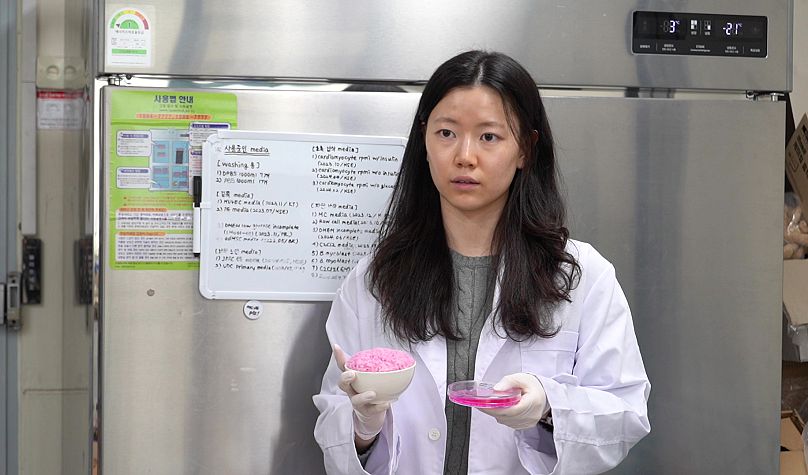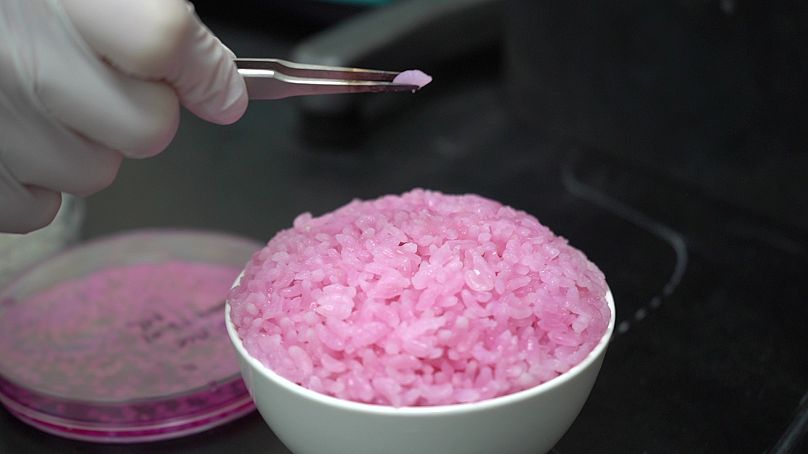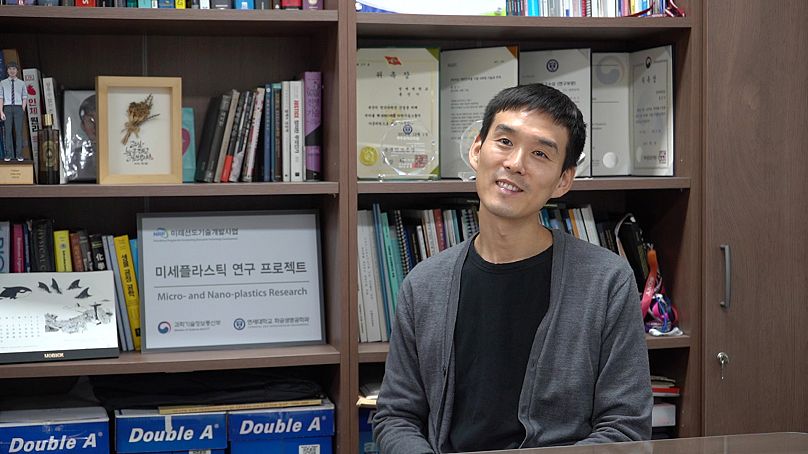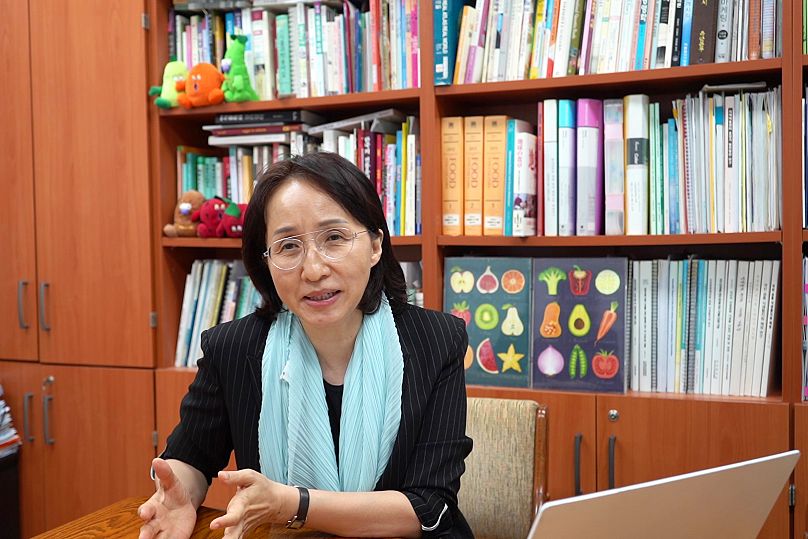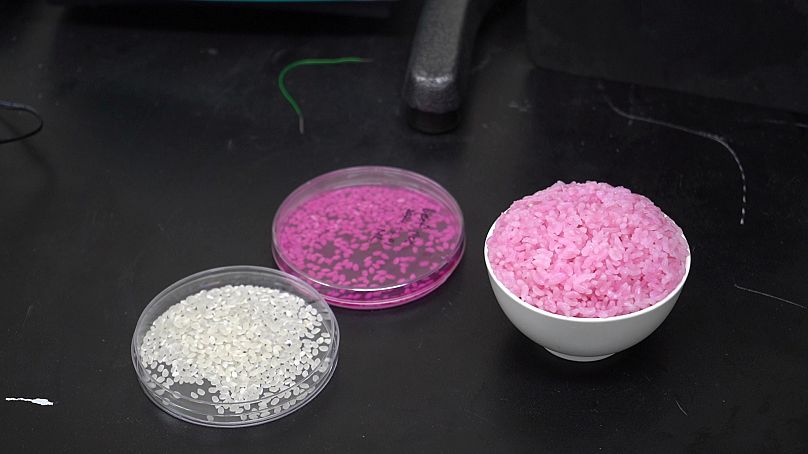A South Korean research team has developed a new hybrid food, an affordable and eco-friendly source of protein, in a bid to develop a sustainable future option.
Inside a small university lab full of whirring equipment, a bowl of cooked rice sits in a fridge.
With its pink and violet hues, it doesn’t quite look like ordinary rice.
“This is rice we have integrated animal cells into, using a substance called gelatin to coat the surface of rice grains on a nano-scale. We cultured them in an incubator at about 37 degrees for about 1-2 weeks and cooked them using a microwave,” Milae Lee, a researcher in the Department of Chemical and Biomolecular Engineering at Yonsei University, told Euronews Health.
In February, biomolecular engineers at Yonsei University in South Korea successfully integrated animal cells into rice grains in a bid to develop a sustainable future food.
Dubbed ‘‘hybrid rice”, the novel food contains 310 mg more protein content per 100 g than the rice did before the experiment, according to the research team.
It also has 160 mg more carbohydrates per 100 g than conventional rice. The research team explains this is due to a delay in carbohydrate decomposition, a process where carbohydrates bind to cell components during cell organisation.
Given that 1 g of beef brisket contains approximately 186.2 mg of protein, eating 100g of hybrid rice can be comparable to eating 100 g of standard rice with 1 g of beef brisket, the research team wrote in **a study**published in the journal Matter.
The research team says this nutritional improvement was due to the fish gelatin and enzymes used to improve the structural stability of the rice grains.
A flavour analysis showed that it tastes similar to normal rice, with a slight hint of animal protein, resembling butter and almonds, followed by a subtle undertone of fat afterwards.
What is cultured meat?
Cultured meat, also known as lab-grown meat, synthetic meat, or cultivated meat, is produced by culturing animal cells in a laboratory instead of raising and slaughtering animals for meat consumption.
It has gained attention as a potential solution to various issues associated with conventional meat production, such as environmental degradation, animal welfare concerns, and public health risks.
“For example, when produced at an industrial scale, developing cultivated meat can be free of antibiotics. So it can really reduce the risk of antimicrobial resistance, which, already in Europe, causes an estimated 133,000 deaths per year,” Seren Kell, head of science and technology at the Good Food Institute Europe, told Euronews Health.
Mark Post was the first in the world to present a proof of concept for cultured meat, a hamburger made out of stem cells, in 2013.
He believes the issue of conventional meat production can partly be attributed to the inefficiency of farming animals.
“Part of that comes from the inefficiency of the animals. So if you can make this more efficient in a lab through cell culture and tissue engineering, you basically can create the same material with less negative externalities,” Post, a professor in sustainable, industrial tissue engineering at the University of Maastricht, told Euronews Health.
The process typically involves taking a small sample of animal cells, such as muscle cells, which then proliferate and divide in vitro. In a process called tissue engineering, these cells are put through a couple of interventions to make muscle tissue and fat tissue which eventually form meat.
“The cells need to be given a certain structure they have to follow. And a rice kernel does that,” said Post.
“Of course, it's small because the rice kernel itself is small. This has been done for many different materials for leaves of trees, for apple slices, and for soybean isolates,” Post added.
Scaffolding is crucial when cultivating animal cells as it helps the cells grow. It also provides some of the important texture in the final meat product.
“It's a really interesting effort to take a widely grown and important crop and use it as a scaffolding for cultivating the animal cells,” said Kell.
“I think it's unlikely to have an immediate impact on European consumers, but I think it's a really nice demonstration of how you can use existing, widely grown crops as ingredients in cultivated meat production,” Kell added.
A ‘platform technology’ that can be used for other grains
The research team is aware that the pinkish colour of the hybrid rice could startle consumers outside Asia.
“In Korea, we are used to different colours of rice as we often add different colours of cereal grains to rice. They are actually thought to be healthier. So I think Koreans and people in Asia are less reluctant to our hybrid rice but I could imagine consumers, for example, in Europe or the US would not be used to the colour of this rice,” Jinkee Hong, a professor in the Department of Chemical and Biomolecular Engineering at Yonsei University, told Euronews Health.
Hong says other eco-friendly ingredients with high cell affinity can be used as a scaffold.
“You can think of it as a ‘platform technology’. Regardless of the type of grain particle, if you want to culture cells on it, you can do it through this specific method we proposed for the first time,” said Hong.
“Of course, depending on the type of grain, this coating may not make everything exactly the same. However, this coating can serve as a foundational technology that significantly contributes to uniformity,” he added.
Hong, who has been involved in lab-grown meat research for the past few years, wanted to overcome its limitations.
“I felt like the progress of cultured meat research was extremely dull worldwide. It felt like there was a barrier existing technologies couldn’t break,” Hong said.
“I believe that cultured meat is a promising area, and I contemplated how to accelerate the progress even if it may not be a perfect solution. It had to be a safe scaffold that everyone can eat, has good compatibility with cells so they grow well, and can be mass-produced conveniently. Each of them was a common limitation in cultured meat,” he added.
Hong says his research team chose rice grains not only because they have a low incidence of allergy but also because Koreans are familiar with the ingredients.
"We tried to put a lot of thought into what we eat and enjoy eating. We tried to come up with something that doesn’t have psychological barriers," Hong said.
“At the same time, we based how the strength and structure [of the scaffolding] should be on existing knowledge in cell biology, especially when nurturing muscle and fat cells. We tried hard to combine these two aspects,” he added.
Rice is a traditional staple in the South Korean diet.
According to data from Statistics Korea, an average Korean consumed 56.4 kg of rice in 2023.
In Europe, per capita annual consumption of milled rice ranges from 3.5 to 5.5 kg in non-rice-growing countries in northern Europe to 6 to 18 kg in southern Europe, according to data from the European Commission published in 2020.
“You would think the main source of protein would be meat. But for Koreans, rice serves as a significant source of protein in their diet,” Jihyun Yoon, a professor in the Department of Food and Nutrition at Seoul National University, told Euronews Health.
"While rice consumption is gradually decreasing [due to globalisation], it remains high in our country overall," she added.
Experts say reflecting food culture is crucial when developing a novel food.
“Food culture, especially in Europe, is really key to people's national identities. It is important that cultivated meat companies respect that and actually tailor their approaches and their products for specific regions or countries,” said Kell.
“There are already some great examples of European companies doing this. For example, Gourmet in France is developing cultivated foie gras cells for food. In Portugal, developing cultivated octopus,” she said.
“In addition to that, we're also seeing lots of them increasingly working with chefs to kind of rely on their creativity. And who also have a very deep understanding of food culture to develop products, that actually meet people's expectations,” Kell added.
According to a report by the APAC Society for Cellular Agriculture (APAC-SCA) published in 2023, 90 per cent of respondents in South Korea said they were willing to try cultivated meat at least once.
However, some experts are sceptical about the widespread consumption and acceptance of cultured meat in the country.
“The reason why Koreans can eat rice every meal without getting tired of it is that it doesn’t really taste like anything. Since there’s no strong flavour, we can enjoy it with various side dishes three times a day,” said Yoon.
“It’s questionable whether it truly can serve its original role as a staple food if we were to make rice shapes using cultured meat”.
Within academia, there's an ongoing debate about whether producing such foods and encouraging their consumption is truly a desirable direction, she added.
“Biotech engineers are highly interested in these advancements. But from the perspective of food nutritionists which encourages the consumption of more natural and eco-friendly food options and less consumption of processed foods, all alternative meats, including cultured meat, would fall into the category of processed foods.
“This is because they typically involve processes where various additives are used to make them resemble meat using the original ingredients".
But the research team behind the hybrid rice says the technology could be used for relief food during emergencies and in underdeveloped countries, during war, and even in space.
Future of lab-grown meat in Europe
The global consulting firm McKinsey predicted in 2021 that the market for cultivated meat could reach €23.4 billion by 2030.
Europe was on the front line of developing a regulatory framework, which is now followed by many other countries.
There are now approvals in Singapore, Israel, and the United States, but not in Europe.
Cell-based meat falls within the scope of the so-called EU novel food framework established for foodstuffs not consumed to a significant degree before May 15, 1998, when the regulation came into force.
All types of novel foods require an assessment by the European Food Safety Authority (EFSA) and marketing approval of the European Commission, which according to Post, takes “relatively long compared to other geographies”.
“The first approval is likely not going to happen within the next two years, maybe after two years, but not within the next two years. Europe is considered one of the hardest, toughest regulatory environments,” he said.
Post believes the future of cultivated meat in Europe is “potentially very bright”.
“Quite honestly, the way we produce meat right now is just not sustainable. So we are going to sooner or later see severe issues with that,” Post said.
“So we all have to hope that this is a technology that allows us to keep eating meat at the rate and pace that we would like, without the sort of disastrous consequences for our environment,” he added.
While consumer acceptance of cultivated meat over the last 10 years has increased, “it will take another couple of years before this can be even somewhat mainstream,” he said.
The hybrid rice is not available for consumers in South Korea yet, as the research team says they are conducting several additional studies.
For more on this story, watch the video in the media player above.












